Thursday, 29 May 2014: Perpignan, closures and fauves
Written
Thursday morning, I came downstairs as usual, chose a table in the breakfast room, set down my Kindle, computer, and water bottle, and turned to the breakfast buffet to find—absolutely nothing. No food, darkened coffee machine, no one in sight. Checked my watch—7 a.m., breakfast should have been in progress for half an hour. No, wait, 29 June is a holiday in France (Feast of the Ascension); breakfast was probably on the weekend schedule, starting an hour later. So I started to set up my computer, to work on the blog until something to eat appeared, but I was interrupted by a staff member coming through from the Novotel (another Accor property) next door. She explained that so few people were staying in the Ibis Budget that morning that they had set up only one buffet, in the Novotel, and that Ibis Budget guests were invited to come on over there. She got out her keys and led me through the locked door that usually separates us rabble from those paying more for their rooms on the other side of the wall. (They have video arranged so that the clerks on the desk in one hotel can watch the desk in the other as needed; that's how she had spotted me waiting in the other breakfast room. The two desks are arranged back to back, with shared office space in between.)
Much more varied breakfast choices on the other side. I took the opportunity to have a boiled egg with my pain au chocolat; they had one of those hot water baths where you take one of the little wire loops put an egg in it, and dangle it into the water (the loop's handle hooks over the side) and leave it to simmer as long as you like. They had a little device with three small hourglasses in it—1 min, 3 min, 5 min—with which to time the cooking process. I turned it over and watched with interest as the 3-min glass ran out just before the 1 min, and the 5 min about 30 sec later. So I have no idea how long I cooked my egg, but it came out fine. Interestingly, the Novotel buffet lacked a microwave and envelopes of instant decaf, which the Ibis Budget provides! Annoyingly, although local markets are overflowing just now with local tree-ripened apricots and sweet cherries, the bowl of fresh fruit contained only apples, rather battered oranges, and kiwifruit. I wondered whether we'd get breakfast there the third day as well, but no, it was only on the holiday.
When David came down (and was led through to the hidden breakfast), we consulted on how to spend the day. We had too many things to see and too little time. We wanted especially to go to Banyuls on Friday for the marine lab's aquarium and the Maillol studio and museum. But we also wanted to visit nearby Collioure, cradle of the Fauve painters. And there in Perpignan, we still had the fine arts museum and the Castillet to see. Now hadn't the lady in the Office de Tourisme said that the Castillet was closed? I thought so; David didn't. We consulted all our research notes and found no evidence that any of the above should be closed on 29 June. Okay, so we'll do the art museum in the morning, and the Castillet in the afternoon. If the Castillet is closed, we'll instead go to Collioure. If both are open, welll do Collioure briefly on the way to Banyuls.
So we finished breakfast promptly and set off the the art museum, only a few blocks away (we had walked by it the previous day and verified its hours, which were neatly painted on the door). As we approached it, I happened to look up and see, neatly printed on a blank window, "Museum closed for renovations." We hoped it wasn't the same museum, but it was—four blank windows later, we came to that door with the name and hours painted on it and no indication of any closure. Why not post the "closed" sign at the address people will look for rather than on the last window in line, half a block away?!
Next up, the Castillet, a pleasant stroll away along the Basse. At least the sign was on the entrance door this time, "Closed for four months for renovations." "But they just renovated in 1993," David complained. "We were here, and we couldn't get in then either!" So we went back to get the car and headed for Collioure on the coast south of Perpignan.
We got there in midmorning, and clearly a lot of other people had beaten us to it. The first several parking areas were filled, and we would up parking way up the hill from the central port, in the parking lot of the local stadium, which consisted of a flat grass field and some bleachers. A few kids were kicking a soccer ball around on it, but the goals at the ends were clearly for rugby. Rugby turns out to the be regional obsession. Who knew?
Collioure was (and still is) incredibly picturesque and colorful, and it was during a summer season there that Henri Matisse and Claude Derain started down the road that became Fauvism. ("Fauve" is French for wild animal.) They wanted to reject anything so constraining as lines and to paint in pure color. Personally, just as I've always thought the impressionists were nearsighted, I've always thought the Fauves were colorblind. But apparently they thought a lot about color—Matisse is quoted as saying, "First I apply one color, then I apply another; if they don't go together, I apply a third that makes them go together." Anyway, I usually associate Fauvism with green skies, red trees, blue people, etc., but at least in that first season at Collioure, you could sort of see where their color choices were coming from.
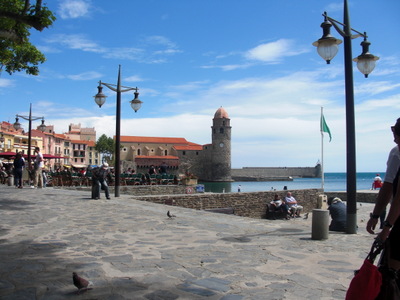
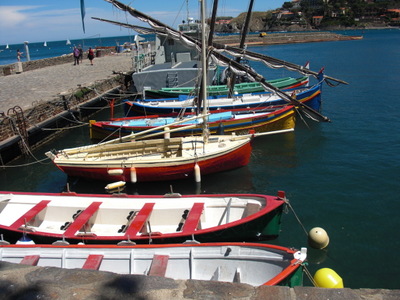 The Office de Tourisme sold us a little booklet about them that provided a key to a circuit of points from which Matisse and Derain had painted the view. At each point, an image of the painting was posted so that you could compare it with the view. Just as well that the paintings were also reproduced in the booklet, as some of the posted ones had faded or otherwise deteriorated. On the other hand, the route map in the booklet was definitely in the fauve style; blotches of color and precious few lines.
The Office de Tourisme sold us a little booklet about them that provided a key to a circuit of points from which Matisse and Derain had painted the view. At each point, an image of the painting was posted so that you could compare it with the view. Just as well that the paintings were also reproduced in the booklet, as some of the posted ones had faded or otherwise deteriorated. On the other hand, the route map in the booklet was definitely in the fauve style; blotches of color and precious few lines.
This view across the old harbor to the light-house was very popular with painters of all schools, and in the little basin just to the right of the photo at the left was this little cluster of brightly painted small fishing boats, no doubt maintained and kept there by the city to fulfill tourist expectation, because all period descriptions of the place emphasized the brightly painted small fishing boats (much more numerous at the time. Just to the right of this photo was a long row of the usual modern fiberglass-and-chrome small pleasure boats.
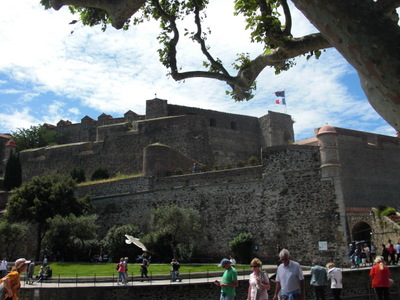
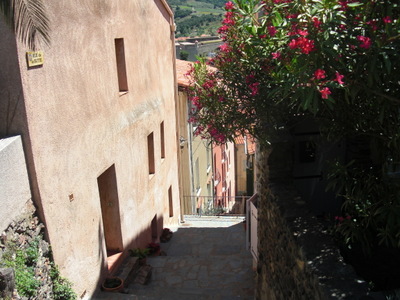 A few hundred yards along the waterfront from the old harbor was this formidable structure, left over from the days when the the town was fortified against foreign powers and pirates. Far, far up the hill behind it, we could see another massive crenelated fortress with a central tower. A steep hiking path led off toward it, but we declined the invitation.
A few hundred yards along the waterfront from the old harbor was this formidable structure, left over from the days when the the town was fortified against foreign powers and pirates. Far, far up the hill behind it, we could see another massive crenelated fortress with a central tower. A steep hiking path led off toward it, but we declined the invitation.
Uphill from the waterfront, where we arrived while following the trail of Fauvist viewpoints, I got this shot down a little street back toward the middle of things. As you can see, the broad, shallow steps turn a corner and give way to a real staircase downward. Steep!
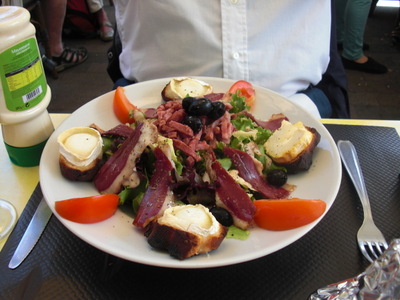
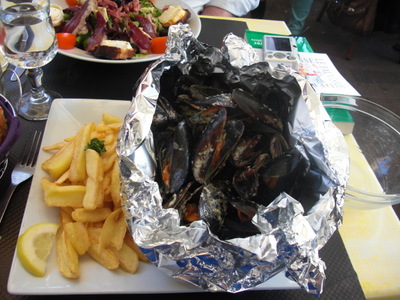 Back down on the waterfront, we sought lunch in a little place called l'Aquarelle (the Watercolor), at an outdoor table across the street from the actual establishment. David chose the Fontfrède salad, with lardons, duck ham, olives, and toasts with grilled goat's cheese.
Back down on the waterfront, we sought lunch in a little place called l'Aquarelle (the Watercolor), at an outdoor table across the street from the actual establishment. David chose the Fontfrède salad, with lardons, duck ham, olives, and toasts with grilled goat's cheese.
I seized the opportunity to have "moules frites," which ought to mean "fried mussels" but is actually the universal name for mussels with fries, especially because one of the sauce options was aioli. As you can see, this place didn't mess around with the usual double cauldron, the lid of which serves to hold the shells as you empty them. They simply piled mussels on a big sheet of heavy-duty foil, dumped sauce on top, wrapped the whole thing up, and plopped it on the flattop to steam for the requisite period. The mussels render some liquid, the aioli melted down all over them, and the result was outstanding! They provided a glass bowl in which to pile the shells, which, as usual, was not quite big enough to hold them all, and bread to soak up the delicious liquid that accumulated in the bottom of the foil package. As you can see in the photo, the place had one of those cutters that makes fries that are V-shaped in cross section, like the ones in Burgundy in 2009.
After lunch, we crossed the little canal through the middle of town to catch the little white train. The price was a little higher than usual, but the ticket stubs were good for a discount on the little white train in Banyuls, where we planned to go the next day, and I was sick of climbing hills on foot.
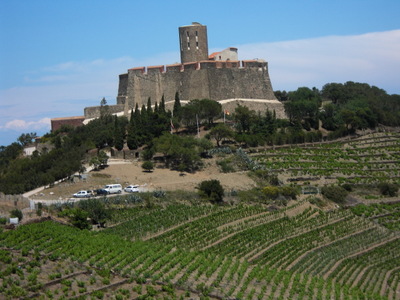
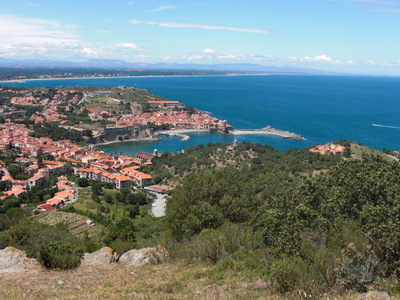 As it turned out, the ride was well worth the price; not only was it 50% longer than the usual 45 min, but it took us, by a long, narrow, steep, winding (not to say hair-raising!) route through the vinyards all the way up to that distant fort on the mountaintop (plus another, now in ruins, that we hadn't spotted)! Along the way, the driver pointed out little groves of cork oaks at various stages of regeneration after their bark had been harvested, and along the way we actually looked down on a deep road cut and tall viaduct that we later drove over.
As it turned out, the ride was well worth the price; not only was it 50% longer than the usual 45 min, but it took us, by a long, narrow, steep, winding (not to say hair-raising!) route through the vinyards all the way up to that distant fort on the mountaintop (plus another, now in ruins, that we hadn't spotted)! Along the way, the driver pointed out little groves of cork oaks at various stages of regeneration after their bark had been harvested, and along the way we actually looked down on a deep road cut and tall viaduct that we later drove over.
At the top, the train stopped for a while so that we could get out and admire the view all the way back down to the old harbor. In the photo at right, you can see the old harbor and lighthouse, the massive waterfront fort, and (directly above the fort) the open green square of the "Stade" just above which our car was parked. In an adjacent little bay, just out of sight to the right of my photo of the view, is the modern port of Port-Vendres, to which the commercial shipping and fishing port has been transferred.
We were a little surprised to find that the mountain-top fort is now privately owned, and a modern house has been built inside, partly wrapped around the central tower (but very carefully engineered not to be visible from the town—I'm sure that was a condition of the building permit).
On the way back, the train took us down the other side of the mountain and through Port-Vendres, which is pretty picturesque in its own right, despite the modern port authority building in the middle. He also happened to stop momentarily right next to a "for sale" sign on some roadside vineyards, planted on about a 45° slope, that bragged "suitable for building, strategic location." But then, it's pretty usual in that part of the world to drive by the doorsteps of houses on one side of the road and their rooftops on the other, so maybe it was suitable for building . . .
And on the way back to Perpignan we encountered perhaps the best surprise of the whole trip. We pulled into a gas station to fill up and, because of the holiday, found it unmanned. David tried anyway, and will wonders never cease!, the pump accepted our credit card! No pin, no signature, no nothing. Just gave us the gas, put it on our account, and said thank you very much, come again. Finally! That will simplify our European travels immensely, not having to find manned gas stations, worry about Sundays and holidays, and whatnot.
Back in Perpignan, we rested our feet, as usual, before going out for dinner, congratulating ourselves on having reserved early, as almost everything was closed for the holiday. At the appointed hour, we strolled over, past the closed museum, to our restaurant, La Table, which was closed. Not note on the door, nothing. It was not only closed and dark, but the little glass-fronted case on the front wall, intended to hold the legally required posted menu) was empty. Now what?!
We walked around the block to make sure it hadn't just moved. We waited a few minutes in case it was opening late. Nothing. Finally, I asked at a little bar around the corner whether they knew what was going on. The owner wasn't surprised it was closed, because almost everything was that day, but he was baffled when I insisted we had reservations. He swore the place was open two nights earlier, but added that it had been sold to new owners a couple of weeks earlier. Well, drat. He recommended La Galinette, but we'd just been there two nights earlier and had reservations for the following night as well; besides, it was quite a hike over there, and we had no reason to believe they'd be open on the holiday.
By that time it was after 8:30 p.m., so we headed for the Place de la République to try to find something to eat. Several places were open, but we could see that there was no food on any of the tables. Even the places that usually served dinner were open only as bars. Finally, we came to a tiny hole-in-the-wall called the Régence Grill, and at the bottom of its menu I spotted "entrecôte pour deux; frites et salade a volonté"—rib steak for two, all-you-can-eat fries and salad." David was skeptical; he'd had bad experiences with French beef, which he's convinced is always hopelessly tough, but I talked him into it. As we waited for our food, we concluded that the place couldn't be as hole-in-the-wallish as it looked, because it had slick menu-placemats and was advertising a drawing for a 50,000-euro car (I entered, just for the heck of it). Later, that conclusion was confirmed, when we came across another like it in another city—it's a chain, but a pretty good one.
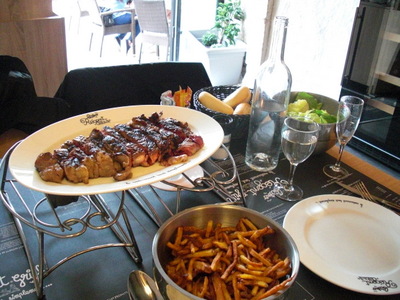
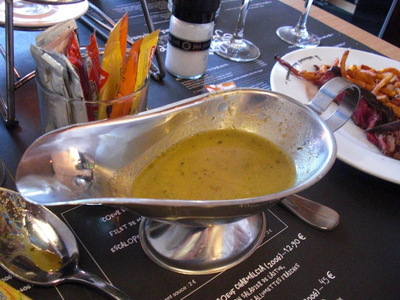 In the end, he was delighted with the choice. The waitress started by lighting two chafing frames and setting our empty plates on top of them to warm. When the food came, she set our warm plates before us and put the platter of steak across the two (the platter developed a hot spot at each end, over the flames, but otherwise remained only warm to the touch). As you can see, the fries were rather overcooked but palatable enough; the salad was excellent—plain buttercrunch lettuce in a very light vinaigrette. Mayo, mustard, and ketchup in little single-serve packets on the table.
In the end, he was delighted with the choice. The waitress started by lighting two chafing frames and setting our empty plates on top of them to warm. When the food came, she set our warm plates before us and put the platter of steak across the two (the platter developed a hot spot at each end, over the flames, but otherwise remained only warm to the touch). As you can see, the fries were rather overcooked but palatable enough; the salad was excellent—plain buttercrunch lettuce in a very light vinaigrette. Mayo, mustard, and ketchup in little single-serve packets on the table.
The steak, essentially a cross section of a large standing rib roast with the bone cut off, was great. We ordered it rare and got it that way, carved into strips for easy serving. It was accompanied (like everything else on the menu) by a sauceboat of "notre fameux sauce charmélcia"—"our infamous charmélcia sauce"—which was also for sale by the pint for take-out. It had a good deal of mustard in it and a lot of herbs, maybe some vinegar, and was probably butter-based, as it congealed on cooling. It was very good, though.
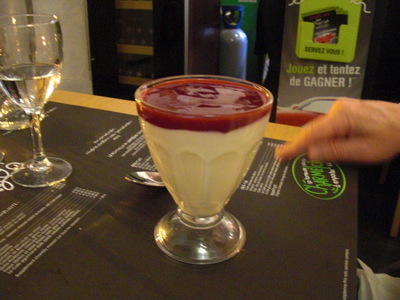
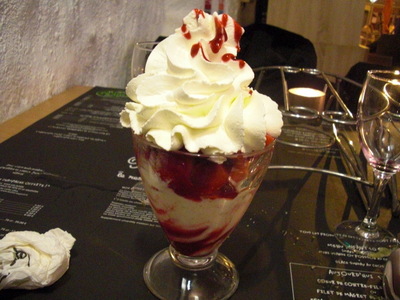 For dessert, David had fromage blanc with red fruit coulis. It wasn't a "faisselle" of fromage blanc, just the stuff you spoon out of a larger container like yogurt, but it was great nonetheless.
For dessert, David had fromage blanc with red fruit coulis. It wasn't a "faisselle" of fromage blanc, just the stuff you spoon out of a larger container like yogurt, but it was great nonetheless.
I had strawberries Melba. A classic peach melba is vanilla ice cream with a poached peach half and red fruit sauce topped with whipped cream. In this one, the peach was simply replaced with strawberries. Very good! I could easily do that at home (if I could get strawberries as good as the ones in France).
So dinner was snatched from the jaws of defeat, and we strolled home happy.
previous entry
List of Entries
next entry

 The Office de Tourisme sold us a little booklet about them that provided a key to a circuit of points from which Matisse and Derain had painted the view. At each point, an image of the painting was posted so that you could compare it with the view. Just as well that the paintings were also reproduced in the booklet, as some of the posted ones had faded or otherwise deteriorated. On the other hand, the route map in the booklet was definitely in the fauve style; blotches of color and precious few lines.
The Office de Tourisme sold us a little booklet about them that provided a key to a circuit of points from which Matisse and Derain had painted the view. At each point, an image of the painting was posted so that you could compare it with the view. Just as well that the paintings were also reproduced in the booklet, as some of the posted ones had faded or otherwise deteriorated. On the other hand, the route map in the booklet was definitely in the fauve style; blotches of color and precious few lines.
 A few hundred yards along the waterfront from the old harbor was this formidable structure, left over from the days when the the town was fortified against foreign powers and pirates. Far, far up the hill behind it, we could see another massive crenelated fortress with a central tower. A steep hiking path led off toward it, but we declined the invitation.
A few hundred yards along the waterfront from the old harbor was this formidable structure, left over from the days when the the town was fortified against foreign powers and pirates. Far, far up the hill behind it, we could see another massive crenelated fortress with a central tower. A steep hiking path led off toward it, but we declined the invitation.
 Back down on the waterfront, we sought lunch in a little place called l'Aquarelle (the Watercolor), at an outdoor table across the street from the actual establishment. David chose the Fontfrède salad, with lardons, duck ham, olives, and toasts with grilled goat's cheese.
Back down on the waterfront, we sought lunch in a little place called l'Aquarelle (the Watercolor), at an outdoor table across the street from the actual establishment. David chose the Fontfrède salad, with lardons, duck ham, olives, and toasts with grilled goat's cheese.
 As it turned out, the ride was well worth the price; not only was it 50% longer than the usual 45 min, but it took us, by a long, narrow, steep, winding (not to say hair-raising!) route through the vinyards all the way up to that distant fort on the mountaintop (plus another, now in ruins, that we hadn't spotted)! Along the way, the driver pointed out little groves of cork oaks at various stages of regeneration after their bark had been harvested, and along the way we actually looked down on a deep road cut and tall viaduct that we later drove over.
As it turned out, the ride was well worth the price; not only was it 50% longer than the usual 45 min, but it took us, by a long, narrow, steep, winding (not to say hair-raising!) route through the vinyards all the way up to that distant fort on the mountaintop (plus another, now in ruins, that we hadn't spotted)! Along the way, the driver pointed out little groves of cork oaks at various stages of regeneration after their bark had been harvested, and along the way we actually looked down on a deep road cut and tall viaduct that we later drove over.
 In the end, he was delighted with the choice. The waitress started by lighting two chafing frames and setting our empty plates on top of them to warm. When the food came, she set our warm plates before us and put the platter of steak across the two (the platter developed a hot spot at each end, over the flames, but otherwise remained only warm to the touch). As you can see, the fries were rather overcooked but palatable enough; the salad was excellent—plain buttercrunch lettuce in a very light vinaigrette. Mayo, mustard, and ketchup in little single-serve packets on the table.
In the end, he was delighted with the choice. The waitress started by lighting two chafing frames and setting our empty plates on top of them to warm. When the food came, she set our warm plates before us and put the platter of steak across the two (the platter developed a hot spot at each end, over the flames, but otherwise remained only warm to the touch). As you can see, the fries were rather overcooked but palatable enough; the salad was excellent—plain buttercrunch lettuce in a very light vinaigrette. Mayo, mustard, and ketchup in little single-serve packets on the table.
 For dessert, David had fromage blanc with red fruit coulis. It wasn't a "faisselle" of fromage blanc, just the stuff you spoon out of a larger container like yogurt, but it was great nonetheless.
For dessert, David had fromage blanc with red fruit coulis. It wasn't a "faisselle" of fromage blanc, just the stuff you spoon out of a larger container like yogurt, but it was great nonetheless.